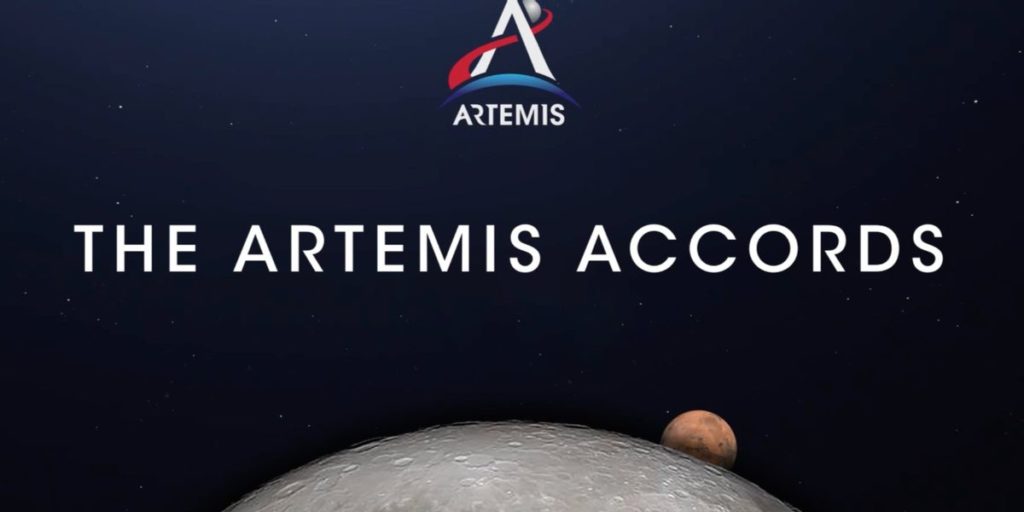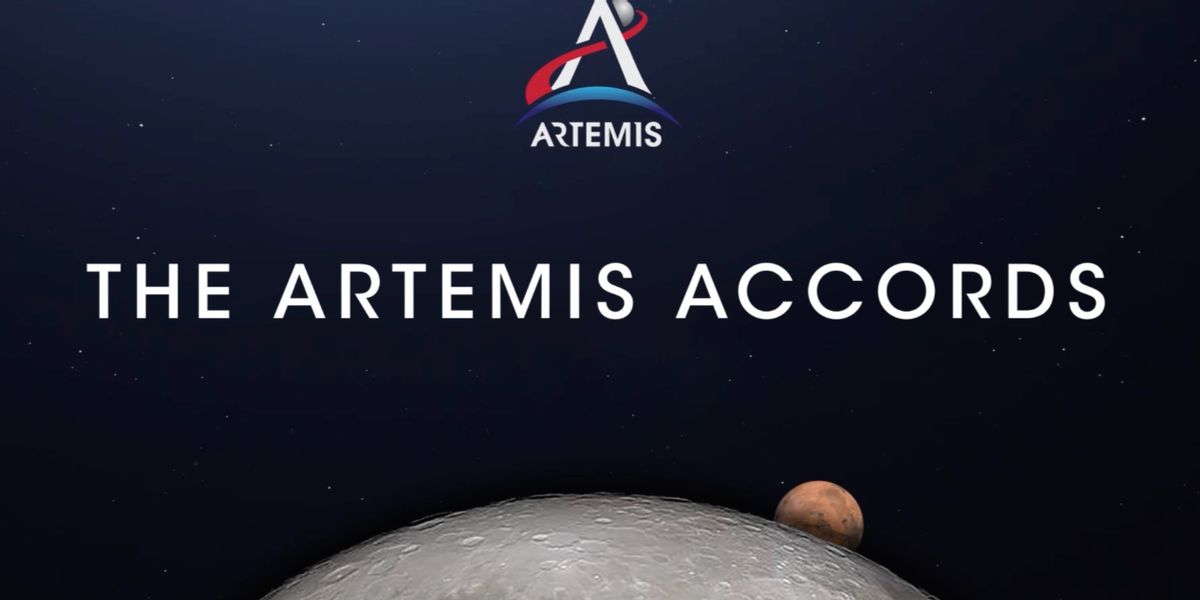Today, NASA announced that eight countries — including the United States — have signed an international agreement known as the Artemis Accords, forming what NASA calls a broad and diverse coalition of nations committed to standardized lunar exploration.

NASA announced its intention to create the Artemis Accords back in May, after working with the US State Department and the National Space Council to come up with a draft set of rules for exploring the Moon. The document’s name refers to NASA’s Artemis program, an ambitious initiative that aims to send the first woman and the next man to the Moon. NASA hopes to partner with multiple countries for the program, and the agency created the Artemis Accords to ensure that other nations could agree on best practices for sending robots and people to the lunar surface.
NASA released the draft of the accords to other space-faring countries, and after getting their input, the agency came up with the final document, which includes standards for things like lunar mining and how to handle conflicts on the Moon’s surface. NASA Administrator Jim Bridenstine says the main goal is to get everyone on the same page about lunar exploration and head off any future international misunderstandings or conflicts. “When we think about the Artemis Accords, what we’re trying to do is establish norms of behavior that every nation can agree to,” Bridenstine said during a press call ahead of the announcement.
The seven nations that have signed along with the US are: Australia, Canada, Japan, Luxembourg, Italy, the United Kingdom, and the United Arab Emirates. NASA says that it has also spoken with other countries interested in signing, but these seven nations were able to go through the interagency process the fastest. That means more countries could be signing on to the accords very soon — even before the end of the year, according to NASA. “This first announcement is very much a beginning, not an ending to the nations joining the Accords,” Mike Gold, NASA’s acting associate administrator for the office of international and interagency relations, said during the briefing.
Notably absent from the initial list is Russia, NASA’s biggest partner in human spaceflight and the International Space Station. Dmitry Rogozin, the head of Russia’s space program, has made it very clear that he is not a fan of the accords or of NASA’s Artemis program. When NASA first announced the accords, Rogozin likened it to a lunar “invasion.” And just yesterday, Rogozin said during a panel at the International Astronautical Congress that the Artemis program is “too US-centric.”
China, another major space power, is also absent, though NASA has long been restricted from partnering or engaging directly with the country on space projects due to a law enacted by Congress. The law would have to change for NASA to approach China, says Bridenstine. “If China’s behavior were to be modified in a way that Congress — Republicans and Democrats — come together and say, ‘Look, we want to engage China,’ NASA stands ready,” said Bridenstine. “But at this point, it’s just not in the cards and we at NASA will always follow the law.”
Long before the creation of the Artemis Accords, countries around the world had already signed a major international agreement focused on how to explore space. Known as the Outer Space Treaty, the agreement entered into force in 1967, establishing that the exploration of space should be a peaceful exercise. It also said that countries should not put weapons of mass destruction in space and that nations should not lay claim to other worlds, among other provisions.
However, the Outer Space Treaty is pretty vague — purposefully so — which means there is a lot of room for interpretation on various clauses. The goal of the Artemis Accords is to provide a little more clarity on how the US wants to explore the Moon without going through the slow treaty-making process. “We are doing this in keeping with the Outer Space Treaty,” said Bridenstine, adding that NASA is trying to “create a dynamic where the Outer Space Treaty can actually be enforced.”
One big thing NASA wanted to make clear in the accords is that countries can own and use resources that are derived from the Moon. As part of the Artemis program, NASA hopes to extract lunar materials, such as the Moon’s dirt or water ice that’s thought to be lurking in the shadows of lunar craters. The Outer Space Treaty forbids nations from staking claim to another planetary body, but the policy of the US is that countries and companies can own the materials they extract from other worlds. “Article II of the Outer Space Treaty says that you cannot appropriate the Moon for national sovereignty,” Bridenstine said. “We fully agree with that and embrace it. We also believe that, just like in the ocean, you can extract resources from the ocean. But that doesn’t mean you own the ocean. You should be able to extract resources from the Moon. Own the resources but not own the Moon.”
It’s an interpretation of the Outer Space Treaty that not everyone may agree on. A pair of researchers writing in the journal Science last week have called on countries to speak up about their objections to this interpretation, and that the United States should go through the United Nations treaty process in order to negotiate on space mining. “NASA’s actions must be seen for what they are—a concerted, strategic effort to redirect international space cooperation in favor of short-term U.S. commercial interests, with little regard for the risks involved,” the researchers wrote in Science.
The accords outline other things like “safety zones” — areas established where work on the Moon is being conducted and where other countries should not interfere. The accords also call for the protection of heritage sites, which could mean the regions where NASA’s Apollo landers touched down on the lunar surface. The document touches on issues of transparency, the sharing of data, registration of space objects, and more.
Another topic addressed by the accords is the idea of interoperability — that spacecraft from various countries should be designed and built to work with hardware from nations all over the world. This is something that even countries that haven’t signed on to the accords can agree on. Yesterday, Russia’s Rogozin called for NASA to design one of its main Artemis elements — a space station to orbit the Moon called the Gateway — so that future Russian vehicles could dock to the station.
Ultimately, the Artemis Accords are still just a set of guidelines, without any defined enforcement mechanisms. There aren’t any real consequences if a country signs the agreement and violates one of the provisions. However, Bridenstine hopes that the involvement of other nations would be enough to ensure that countries behave in accordance with the accords. “I think that there’s a lot of pressure that can be brought to bear on countries that choose to be part of the Artemis program but then don’t play by the rules,” he said.
The Verge

Leave a Reply
You must be logged in to post a comment.